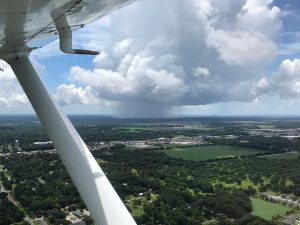
Here’s the situation: You’re driving to the airport. You’re concerned about the weather, but hopeful you can still get that flight in.
You took notice of some forecast nasty weather in your earlier pre-flight briefings, but maybe it will hold off until later in the day.
Then you see this:

Uh oh.
No, the weather doesn’t always follow the forecast. Any forecaster (and any pilot) can tell you that! That’s why it’s important to prepare for any and all possibilities. That way, even if the weather does goes sideways, you have a “Plan B.” Actually, it would be wise to also have a “Plan C” and “Plan D” as well.

Your ability to evaluate the weather is a big part of exercising your responsibility as pilot in command (PIC) of whatever you are flying. Don’t be afraid to say “no” when it comes to the go/no-go decision when the weather pushes up against your personal minimums.
Along the same lines as a go-around, trying to save a bad approach, don’t try to salvage a trip or day of flying by trying to rationalize your decision by saying to yourself “I can make this work out…I think.”
Hope and wishful thinking are not good substitutes for sound decision making skills. The best way to get those skills: Practice! That means spending some quality time finding your favorite weather websites.
On that note, it’s important that you find quality, reliable and reputable sources of weather information.
NOAA’s Aviation Weather Center is an excellent starting point. That starting point should begin DAYS in advance of your planned flight, not just a quick glance at the computer screen in the flight planning room at the FBO.
Even worse: Simply plugging the flight plan into your Electronic Flight Bag (EFB) software and allowing it to make choices for you. YOU are the PIC and YOU are required to “become familiar with all available information concerning that flight.” It’s a pretty broad statement but it’s in the regs.
Think of it this way: If anything went wrong with the flight and the FAA came calling, would your weather pre-flight planning be worthy?
While in flight, your weather analysis hasn’t ended. Look ahead. See that rain shower that’s about to become a severe thunderstorm? Or is it?
Knowing weather trends, winds aloft and having the power of observation can keep you out of trouble during the flight. Sure, FIS-B and Sirius XM weather are great tools to have in the cockpit, but know, understand and respect the limitations that come with those tools.

Leave a Reply